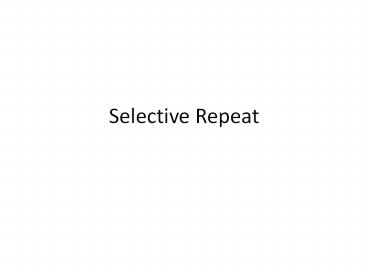Selective Repeat - PowerPoint PPT Presentation
Title:
Selective Repeat
Description:
Receiver has a window greater than 1. ... If network layer got data, if current window not full yet, read data, send to ... outside the window, don't do ... – PowerPoint PPT presentation
Number of Views:182
Avg rating:3.0/5.0
Title: Selective Repeat
1
Selective Repeat
2
Selective Repeat (Protocol 5)
- Further optimization.
- Receiver has a window greater than 1.
- Dont discard frames simply because some earlier
frames was damaged.
3
Selective Repeat
- Sender.
- while (1)
- If network layer got data, if current
window not full yet, read data, send to physical
layer with the current frame ID. Start timer.
Increment frame ID by one. - If got ACKm, if m is outside the
window, dont do anything. If m is inside the
window, consider all frames in the window with
frame ID less than the m acked. Forward window to
m. - If timeout for frame m, resend m.
- Receiver
- while (1)
- Get frame from the physical layer. If
it is within the receiver window and hasnt been
received before, fill in the slot, and forward
the beginning of the receiver window if
necessary. Deliver to the network layer all
frames between the beginning of the old receiver
window and the new receiver window 1,
inclusive. Send ACK (Expc the beginning of the
current receiver window). - Note assuming the sequence number is the frame
ID.
4
The Timer
- Each packet in the senders window should have a
timer. - If the window contains F0,F1,F2,F3. Could it
happen that the when the timer for F0 expires,
the timer for F1 has not expired yet? Yes, if you
do not send the frames one-by-one. - Could it happen that the timer for F1 expires but
the timer for F0 has not? Yes, if F0 has been
retransmitted before.
5
Sequence Number
- If the sequence number field is 3 bits, how large
should the sender/receiver window be? - Should the receiver has a different window size
than the sender? No, larger --- makes no sense,
the sender is not going to send that many
outstanding frames, smaller --- wrong, because
the receiver will discard such packets. - Window size should be 4.
6
Sequence Number
- For 0 to be in my window again, I must have
forwarded to 5. When I forwarded to 5, I must
have got 4. I got 4 because the sender sent 4.
The sender sent 4 only if it got ACK for 0.
7
Sequence Number
- A proof.
- Let the sequence number be log_2N bits. Let the
window size be W, where W lt N/2. - Suppose the receiver gets a frame with sequence
number m. He thinks it is for frame x. Could he
actually receive frame x-N (with the same seq)? - No. Because when x is in his window, the window
has forwarded to x-W1, at least. So he has got
x-W. The sender has sent x-W. The sender will do
so only if it has got ACK for x-2W1. If W ltN/2,
the sender must have got ACK for x-N.
8
Selective Repeat
9
Piggybacking
- Considered only one direction. Bidirection.
- Piggybacking
- Combining ACK with data
- When no data?
- Wait some time and ACK anyway.
- Internet. PPP.
10
Framing
- How does the receiver know where is the start and
where is the end of a frame? - Counter. Tell the receiver how many bytes there
are in this frame. Problems? - The counter part could be corrupted and you are
done.
11
Flag Bytes
- Add special bytes to the beginning and the end of
the frame. - Problems?
- What if the data contains the flag bytes?
- Add ESC byte to each flag or ESC in the data.
Stuffing.































